- Home
- Deborah Harkness
The World of All Souls Page 5
The World of All Souls Read online
Page 5
Diana joins the Knights of Lazarus near Benjamin’s compound in Chelm. The Knights of Lazarus kill Benjamin’s supporters, and Diana finally kills Benjamin with the golden arrowhead. Matthew returns to their home at Les Revenants broken in body and spirit, but he heals gradually under Ysabeau’s and Diana’s care. The only remaining task is to have the covenant formally revoked. The entire family works to provide evidence that the covenant was based on a fundamental misunderstanding. Procreation between creatures does not result in monsters.
But the question remains: Why can weavers and blood-rage vampires conceive children? Diana already knows the answer; it was written in the pages of the Book of Life. Matthew, Miriam, and Chris provide the modern science that supports her ancient understanding. Their DNA evidence proves that creatures are not separate species but just “humans with a difference.”
Diana travels to Venice and presents their case to the Congregation. The covenant is repealed, and the de Clermont family unanimously appoints Diana as their delegate to the Congregation. Afterward the ghost of Philippe returns to Diana the gold-and-silver arrow she shot into Benjamin’s heart. Diana is to continue Philippe’s work of dispensing justice on the goddess’s behalf. The goddess is still not finished with Diana.
When I decided that Diana and Matthew were going to travel back to 1590, it soon became clear that the existence of a new calendar was going to throw a monkey wrench in the plot. Because Shadow of Night is a work of fiction, I had to find some way to weave the calendar problem into the plot or run the risk of confusing my readers. I decided this historical rift in time added to the timewalking element of the story and let Diana reflect on the discrepancy as further evidence of just how fluid time can be. Keeping all the dates straight was something of a nightmare (you should see my tea-stained, much-revised working calendar complete with phases of the moon and sunrise/sunset times), but it did mean that Diana and Matthew got to celebrate Christmas twice.
Calendars
The Forty Days of A Discovery of Witches
Alchemy is woven into every aspect of the All Souls story from the very beginning, even down to the timings. The action of A Discovery of Witches takes place over forty days and is purposely structured to mirror the forty days of an alchemical experiment. Forty was a significant number in alchemy, as Mary Sidney pointed out to Diana when they were working in her laboratory. Mary was delighted when her own experiment with the arbor Dianae took exactly forty days to complete, “just as the sages promised.”
The Julian/Gregorian Calendars of Shadow of Night
Not only does Matthew and Diana’s visit to the sixteenth century involve timewalking from the present, but they also have other time warps to navigate. When people went to bed on October 4, 1582, a time rift of sorts opened up in Western Europe. In most places people woke up and it was October 5. But in the Polish-Lithuanian region, Portugal, Spain, and most of Italy, the next day was officially October 15. Timewalkers were not to blame. Instead the loss of ten days was the result of Pope Gregory XIII’s new calendar.
Why did Europe need a new calendar? Because the old Roman calendar put in place by Julius Caesar (the Julian calendar) instituted a calculation error that meant it gradually drifted away from key astronomical markers of the season, like solstices and equinoxes. By the sixteenth century, the spring equinox fell on March 11 according to the calendar—not March 21—thereby affecting the calculation of important, movable Christian celebrations like Easter.
This new-style Gregorian calendar made Diana and Matthew’s time travel back to 1590 even more complicated. For while most of Catholic Europe (including France and Bohemia) had adopted the pope’s new calendar by 1590, Protestant Europe (including England and parts of present-day Germany) stuck to the old-style Julian calendar. For Shadow of Night, it meant that France and Prague were ten days ahead of England.
This can lead to some confusion about dates. When did the Spanish Armada start, for instance? According to the Spanish, who used the new-style calendar, it began when their fleet set sail on May 20, 1588. According to the English, who used the old-style calendar, it began on May 10, 1588. Same day, different calendar.
The curious might wonder when England and its American colonies adopted the new calendar. That was in 1752. By then they had to skip eleven days to bring the date into proper alignment with the astronomical data.
The All Souls Year
Mabon, September 21. This is an important day in the world of the All Souls trilogy: the day that Diana met Matthew at the Bodleian Library. I’m a historian, so dates are important (though not as important as high-school history classes suggest . . .), and I chose this one with care. There are many other aspects of the celebration—the harvest, the wise-crone aspect of the goddess—but for me it was this idea of balance that made it the perfect moment for the two main characters to meet. As for where they met, it had to be the Bodleian Library. According to Matthew, the moment he saw Diana using magic to remove a book from the top shelf on the library balcony, he fell in love. When I was writing this chapter, I listened to “Aim Snap Fall” by the Spill Canvas a number of times, since it seemed to capture that moment when Cupid’s arrow landed.
Music of All Souls
MATTHEW
“Brezairola,” Anúna
“There Will Be a Light,” Ben Harper
“Human,” Civil Twilight
“If You Find Her,” Future of Forestry
“Ozymandias,” Guggenheim Grotto
“Behind Your Eyes,” Jon Foreman
“The Curse,” Josh Ritter
“Only You,” Joshua Radin
“Breathe,” Peirson Ross
“Blackbird,” Sean McCue, Michelle Beauchesne
“Under My Skin,” Peter Bradley Adams
“So Are You to Me,” Peter Bradley Adams
“Cover of Night,” Steve Reynolds, Tom McRae
“After Afterall,” William Fitzsimmons
“Secret,” Seal
“I’m Gonna Be (500 Miles),” Sleeping at Last
“Not with Haste,” Mumford & Sons
DIANA
“Frost,” Rachael Sage
“All Your Sisters,” Mazzy Star
“A Map of Shadows,” Carrie Newcomer
“Are We There Yet?,” Ingrid Michaelson
“Several Angels,” Thea Gilmore
“Answer,” Sarah McLachlan
“The Thief,” Brooke Fraser
“All This and Heaven Too,” Florence and the Machine
“The Goodnight Song,” Webb Sisters
“Landslide,” Dixie Chicks
“Old Soul,” Thea Gilmore
“Watershed,” Vienna Teng
“I Will Love You,” Fisher
“Heroine,” Edge, with Sinéad O’Connor
“Set Fire to the Rain,” Adele
“White Bird,” KT Tunstall
“Bring On the Wonder,” Sarah McLachlan
“Music of the Moon,” Martha Tilston
“When You Grow Old,” Smoke Fairies
“Story of Us,” Sarah Fimm
“Keep Breathing,” Ingrid Michaelson
“Hourglass,” Sandra McCracken
“Always You (Bonus Track),” Ingrid Michaelson
“1000 Stars,” Webb Sisters
“The Rowan Tree,” Traditional, James Galway, the Chieftains
YSABEAU AND PHILIPPE
“The Blood and the Wine,” David Berkeley
“Too Far Gone,” Lisa Gerrard
“Love’s Secret,” Michael Whalen<
br />
“Trusty and True,” Damien Rice
“The Peace of the Wild Things/Dayblind,” Crooked Still
“A Beginning Song,” Decemberists
“I Have Loved You for a Thousand Lifetimes,” Michael Whalen
“Cosmic Love,” Florence and the Machine
“Broken Crown,” David Berkeley
“Have I Loved?,” Down Like Silver
“Blood/Chest,” William Fitzsimmons
“I Am Stretched on Your Grave,” Kate Rusby
To listen to these soundtracks and others, visit Deborah Harkness’s website or follow her on Spotify.
Creatures
The Creatures of All Souls
There are four types of hominid creatures in the world of All Souls: daemons, humans, vampires, and witches. They have existed side by side for millennia, and though humans have always been in the majority, in the past that majority was far slimmer than it is today. Now humans represent about 90 percent of the population, and the other three creatures, which are apparently becoming weaker, only roughly 10 percent.
At various times in history, humans have been forced to acknowledge that there were creatures Not Like Them in their world. In antiquity, and in the early Middle Ages, there were periods of vampire warfare while the early modern period was a time of great magical fertility. And daemons were especially prolific in the eighteenth century. Typically the humans resorted to myth, fairy tales, and the linked responses of celebrity or scapegoating to come to terms with these intrusions of Otherness into their world.
At a genetic level, there are some distinctions between creatures. Scientists like Matthew Clairmont are just beginning to probe those differences—though they rightly fear that such knowledge could result in eugenics and genocide if discovered by the wider population. Daemons have a single extra chromosome while witches and vampires have an extra pair of chromosomes. For witches the extra chromosome pair is inherited through descent. For vampires the extra pair is a forced genetic mutation resulting from the flood of DNA that is absorbed at the moment they ingest their maker’s blood (all of which, incidentally, is compatible with modern genetic research). Humans, witches, and daemons are also grouped together under the term “warmblood.”
At the moment, most creatures believe that they are each entirely different species. This is reminiscent of nineteenth-century race theory, which posited that African and Asian peoples were different species rather than phenotypically different members of the same race. As with nineteenth-century proponents of racial purity, creatures believe that different species either cannot or should not mix.
While informal segregation has sadly always existed, formal segregation has been increasing in the world of All Souls. The unwanted human attention on the minority cultures living among them resulted in the establishment in the twelfth century of the Congregation, a formal institution ostensibly founded to ensure the safety of daemons, vampires, and witches through self-segregation. However, the creation of the Bishop-Clairmont scion has now challenged the old laws. With the covenant overturned at the end of The Book of Life, the destructive divisions between creatures could finally be dissolved.
Daemons
Even though they’d followed me around college, I knew even less about daemons than I did about vampires. Few seemed to understand the creatures, and Sarah had never been able to answer my questions about them.
Characteristics
Daemons are creative, artistic creatures who walk a tightrope between madness and genius. They live life in a chaotic fashion yet show great affection for those around them who share their ideals. Their strongest distinguishing characteristic is awe-inspiring creativity. They are exceptionally talented and often have a love for music and art. They can also be unstable, however, and toggle between bursts of wildly productive activity and dangerous depressions. By turns dreamy and intense, mercurial daemons live the same ordinary life span as witches and humans but with such intensity and so little sleep that they seem to live several lifetimes in one.
Sarah Bishop says that daemons are either rock stars or serial killers. While overly simplistic, this assessment contains a kernel of truth. Because daemons are brilliant and intensely creative creatures, they do gravitate toward high-risk/high-reward careers like pop music. They are also found in professions as diverse as computer programming and gaming, hedge-fund management, music, theater, and the graphic arts. Many of our foremost writers of plays and novels, both past and present, are daemons. In modern times daemons frequently appear on the bestseller lists and in feature articles in the New York Times and the Sunday Times in the UK. Some notable daemons past and present have included Christopher Marlowe, Wolfgang Amadeus Mozart, Nikola Tesla, Georgia O’Keeffe, Jimi Hendrix, Remedios Varo, and Jonathan James.
Many, if not most, rock stars and, indeed, concert musicians and other musical prodigies, painters, sculptors, fashion designers, and actors are daemons. And the individuals who surround these artists, including actors’ entourages, paparazzi, and various groupies, are often young daemons, drawn like moths to their flame. Daemons are addicted to fashion, too. They make trends as well as follow them and always know the best bars, restaurants, and clubs.
Many daemons walk the halls of colleges and universities around the globe, though given the nature of daemons, those institutions cannot always contain them tidily. Historically, they were drawn to the study of mathematics, alchemy, and astronomy. Their scholarship and contributions were especially prolific throughout the eighteenth century, during the period popularly known as the Enlightenment. Today daemons continue to make contributions in areas ranging from biology to history, in physics, mathematics, and computer science. They are particularly drawn to the creative possibilities of multidisciplinary fields, such as the history of science and computational bioinformatics (which develops software tools to analyze biological data).
There is, of course, a darker side to daemons. While serial killing is not exactly a profession, it is true that the genius of some daemons can spin toward madness and even, in a few regrettable instances, murder. More often, however, young daemons engage in crimes of impulse and opportunity, like street brawling, petty thievery, or counting cards in Las Vegas casinos. Others who prefer to avoid crowds and the possibility of being physically attacked may engage in counterfeiting artwork and historical artifacts or the sophisticated and destructive enterprise of computer hacking.
In general, however, daemons are more of a nuisance than a danger. This stands in sharp contrast to vampires and humans, creatures who are truly lethal but seem to get much better press, perhaps due to their superficial charms and tremendous powers of deception. When it is possible to identify, channel, and cultivate their creativity and intelligence, daemons can be valued members of society.
Preternaturally gifted and unpredictable, daemons tend to exhibit their traits at puberty in one of two ways: extraordinary mental and/or creative abilities or madness. Teenage daemons are at great risk of harm from drug abuse, homelessness, and aggressive mental-health treatments. And because they are often born to perfectly ordinary humans, they can be unwelcome in their biological families, marginalized and misunderstood. In those rare cases where they are born to understanding families who nurture their tremendous gifts, daemons can be unusually stable and competent and go on to accomplish remarkable things.
Unlike vampires, most daemons do not have any particular scent that is detectable to witches. Some witches, however, report that the gaze of a daemon is unsettling and feels like a kiss or being nudged by an unseen hand. Many daemons also possess glimmerings of supernatural power. Although they cannot enchant objects as witches do, some report having precognitive visions of the future and the ability to read the minds of others—though these readings and visions, like daemons themselves, are not always entirely reliable.
Daemons struggle with
repetitive tasks like housekeeping and, in their distraction, lose things constantly—keys, wallets and purses, eyeglasses, and cell phones. They often wander around parking garages for hours in search of their vehicles. Many daemons are fantastic chefs, but their kitchens are in constant disarray, with pots and pans going unwashed for weeks. A large majority of them are impeccably dressed, but some can be a bit scruffy. They may let personal hygiene take a decided backseat in moments of inspiration (or madness), leaving their shoelaces untied, wearing clashing colors and patterns, or misbuttoning their clothing. Indeed, daemons have on multiple occasions inadvertently started popular fashion trends like the lumbersexual beard, the wearing of mismatched socks or underwear as outerwear, and dressing in white year-round.

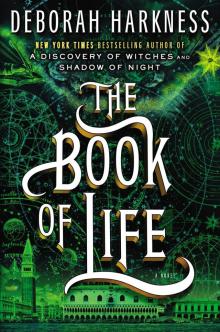 The Book of Life
The Book of Life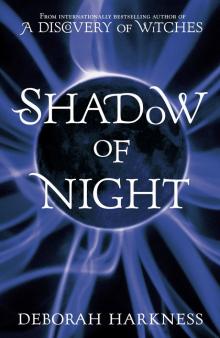 Shadow of Night
Shadow of Night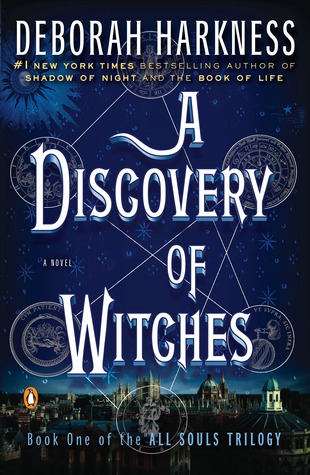 A Discovery of Witches
A Discovery of Witches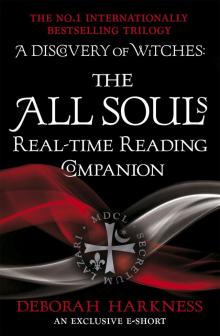 The All Souls Real-Time Reading Companion
The All Souls Real-Time Reading Companion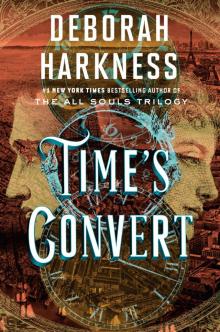 Time's Convert
Time's Convert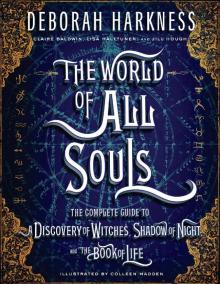 The World of All Souls
The World of All Souls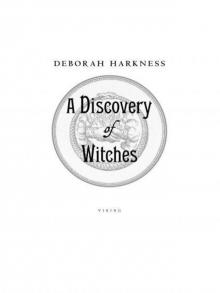 A Discovery of Witches: A Novel (All Souls Trilogy)
A Discovery of Witches: A Novel (All Souls Trilogy) Shadow of Night: A Novel
Shadow of Night: A Novel